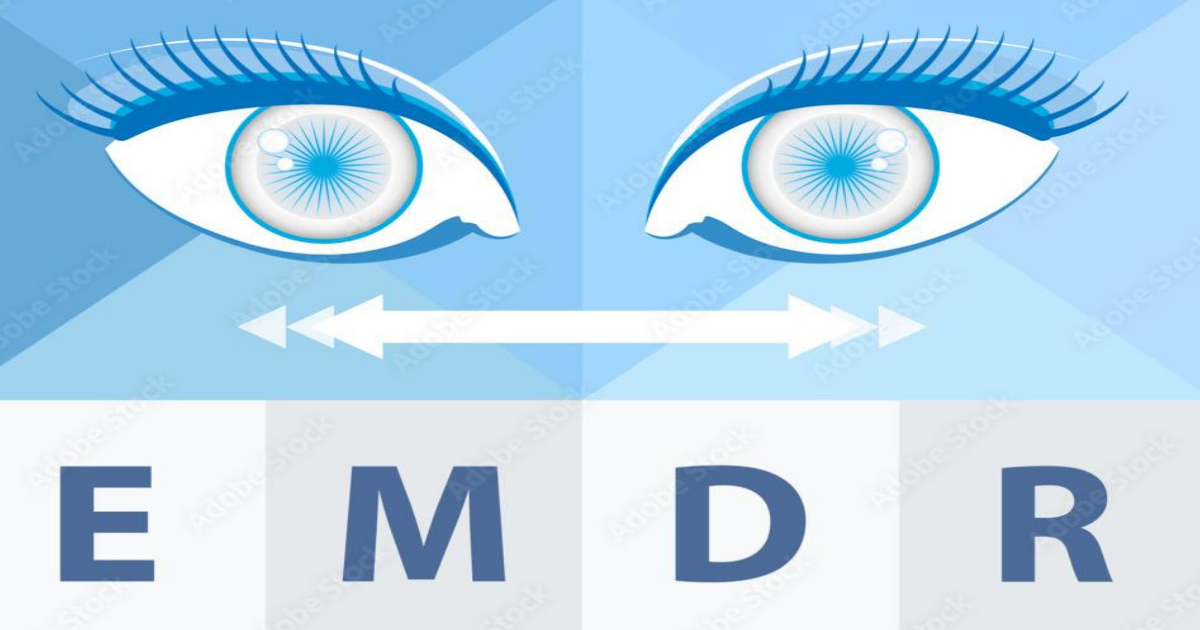Contents
- 1 Introduction
- 2 Notable Figures in Eye Movement Desensitization and Reprocessing
- 3 Applications of Eye Movement Desensitization and Reprocessing in Treating Mental Health Disorders
- 4 Common Myths of Eye Movement Desensitization and Reprocessing
- 5 Criticisms of Eye Movement Desensitization and Reprocessing (EMDR)
- 6 Conclusion
Introduction

Eye Movement Desensitization and Reprocessing (EMDR): Techniques, Applications, and Effectiveness
Eye Movement Desensitization and Reprocessing (EMDR) is a structured therapeutic approach that helps individuals process and integrate traumatic memories by using bilateral stimulation, such as eye movements, taps, or sounds. EMDR therapy is based on the Adaptive Information Processing (AIP) model, which suggests that distressing memories are stored maladaptively in the brain. By activating the brain’s natural healing processes, EMDR allows individuals to transform these memories and alleviate psychological distress.
This article explores the foundational principles of Eye Movement Desensitization and Reprocessing (EMDR), a therapeutic approach designed to help individuals process and resolve traumatic memories and stress. It provides an in-depth look at the core techniques of EMDR, including the specific methods used during therapy sessions to facilitate the processing of distressing memories.
What is Eye Movement Desensitization and Reprocessing (EMDR)?
Eye Movement Desensitization and Reprocessing (EMDR) is a psychotherapy approach developed to alleviate the distress associated with traumatic memories. Developed by Francine Shapiro in the late 1980s, EMDR is grounded in the idea that traumatic experiences can overwhelm the brain’s natural ability to process information, leading to lingering emotional distress. EMDR integrates elements from various therapeutic modalities, including cognitive-behavioral therapy (CBT), psychodynamic therapy, and mindfulness, to help individuals reprocess and integrate traumatic memories.
For example, a combat veteran suffering from PTSD might work with an EMDR therapist who asks them to recall a particularly distressing memory while following the therapist’s finger movements with their eyes. As the veteran focuses on the traumatic event and engages in bilateral stimulation, the emotional intensity of the memory begins to diminish. This process leads to a significant reduction in PTSD symptoms, such as flashbacks and hyperarousal, allowing the veteran to feel a greater sense of safety and emotional stability.
Why is EMDR Important?
EMDR is important because it provides an evidence-based method for addressing trauma and other psychological conditions without requiring individuals to engage in prolonged exposure to distressing memories or intensive verbal processing. EMDR has been recognized by organizations like the World Health Organization (WHO) and the American Psychological Association (APA) as an effective treatment for trauma-related disorders. Its structured protocol helps individuals reprocess traumatic memories, reduce psychological distress, and promote emotional healing.
Techniques Used In EMDR
- Bilateral Stimulation (BLS): This fundamental technique involves using rhythmic, alternating stimuli—such as eye movements, taps, or auditory tones—to stimulate both hemispheres of the brain. By engaging in BLS while focusing on distressing memories, individuals can reduce the emotional charge associated with these memories, facilitating their reprocessing and integration.
- Cognitive Interweave: During this technique, the therapist helps the individual to identify and challenge negative beliefs associated with the trauma. By integrating positive and adaptive thoughts, individuals can reframe their experiences and replace maladaptive beliefs with more constructive and empowering ones.
- Resource Development and Installation (RDI): This technique involves helping individuals identify and strengthen internal resources or positive qualities they possess. By installing these resources through BLS, individuals can develop a greater sense of self-efficacy and resilience, which aids in processing traumatic memories more effectively.
- Safe Place Imagery: In this technique, individuals are guided to create and visualize a mental “safe place” where they feel secure and calm. This imagery serves as a grounding tool during sessions, helping individuals manage anxiety and emotional distress related to the traumatic memories being processed.
8 Phase Protocol in EMDR
History Taking and Treatment Planning: The therapist gathers information about the client’s history and identifies target memories for processing. This phase involves understanding the client’s trauma and current symptoms to develop a treatment plan.
Preparation: The therapist explains the EMDR process to the client and establishes a sense of safety. Techniques for self-soothing and grounding are introduced to help manage distress during sessions.
Assessment: The client and therapist identify specific negative beliefs associated with the target memory and desired positive beliefs to replace them. The client rates the level of distress and the validity of the positive beliefs.
Desensitization: Mental images, visualizations, and fantasies that a person has, including both positive and negative (e.g., intrusive traumatic memories) mental pictures that impact their emotional and psychological state.
Installation: The therapist helps the client integrate the positive beliefs identified during the assessment phase. Bilateral stimulation is used to reinforce these positive beliefs and increase their validity.
Body Scan: The client scans their body for any residual tension or discomfort related to the target memory. The therapist uses bilateral stimulation to address any remaining physical or emotional distress.
Closure: The session ends with techniques to help the client return to a state of equilibrium. The therapist ensures the client feels stable and provides self-care strategies to manage any residual distress.
Reevaluation: At the beginning of subsequent sessions, the therapist evaluates the client’s progress, assesses the impact of the processed memories, and determines if further processing or additional targets are needed.
Notable Figures in Eye Movement Desensitization and Reprocessing
Francine Shapiro: The founder of EMDR, Francine Shapiro developed the therapy as a method to alleviate distress associated with traumatic memories. Her groundbreaking work has established EMDR as a prominent treatment for trauma and PTSD.
David Servan-Schreiber: A French psychiatrist and researcher who popularized EMDR in Europe and wrote extensively on its effectiveness in treating trauma and emotional disorders.
Laurel Parnell: A well-known EMDR practitioner and author who developed the “Attachment-Focused EMDR” approach, which integrates attachment theory with EMDR to address developmental trauma.
David Servan-Schreiber – Image Source: femmeactuelle.fr

Theories Influenced by Eye Movement Desensitization and Reprocessing
- Dialectical Behavior Therapy (DBT): Developed by Marsha Linehan, DBT is designed for clients with emotional dysregulation, particularly those with borderline personality disorder. It combines cognitive-behavioral techniques with mindfulness and acceptance strategies. DBT focuses on enhancing emotional regulation, interpersonal effectiveness, distress tolerance, and acceptance.
- Compassion-Focused Therapy (CFT): Created by Paul Gilbert, CFT integrates cognitive restructuring with self-compassion to address trauma-related shame and self-criticism. The therapy aims to build self-compassion and address negative self-evaluations. It emphasizes fostering a supportive and understanding internal dialogue to improve emotional well-being.
- Adaptive Information Processing (AIP) Model: The AIP model underpins EMDR, proposing that the mind has an inherent capacity to process and integrate experiences into adaptive memory networks. According to AIP, traumatic memories can become maladaptive if not properly processed. EMDR aims to facilitate the reprocessing of these memories to restore adaptive functioning.
- Somatic Experiencing: SE therapies focus on the interplay between the mind and body, emphasizing physical sensations and bodily experiences in healing. These therapies aim to address trauma by increasing awareness of bodily responses and integrating this awareness into therapeutic processes. They emphasize the importance of physical experiences in emotional healing.
Applications of Eye Movement Desensitization and Reprocessing in Treating Mental Health Disorders

PTSD
EMDR is particularly effective for treating post-traumatic stress disorder (PTSD) by facilitating the reprocessing of traumatic memories and reducing the distress associated with them. The therapy helps individuals access and address distressing memories through bilateral stimulation, such as eye movements.
Example: For a client experiencing PTSD, EMDR techniques such as bilateral stimulation (eye movements, taps, or sounds) while focusing on traumatic memories can help desensitize the emotional impact of these memories. This reprocessing leads to reduced symptoms like flashbacks and hypervigilance, promoting a sense of safety and emotional stability.
Image Source: healthgrades.com

Anxiety Disorders
EMDR can be used to treat various anxiety disorders by reprocessing distressing memories or deeply ingrained beliefs that contribute to heightened anxiety. By targeting specific traumatic or distressing events, EMDR helps individuals process and integrate these memories, reducing their emotional charge and impact on current anxiety levels.
Example: For a client with general anxiety, EMDR techniques such as bilateral stimulation (through eye movements, taps, or sounds) are used while the client focuses on specific distressing memories or negative beliefs contributing to their anxiety. This reprocessing helps diminish the emotional intensity of these memories or beliefs, leading to reduced anxiety symptoms and increased emotional resilience.
Image Source: capecodtimes.com

Depression
EMDR is effective for treating depression by addressing and reprocessing negative self-beliefs and unresolved traumatic experiences that contribute to depressive symptoms. The therapy focuses on identifying and targeting specific memories and negative core beliefs that exacerbate feelings of hopelessness and worthlessness
Example: For a client experiencing depression, EMDR techniques like “Resource Development and Installation” (RDI) can help them build internal resources and positive coping strategies. This approach helps to reprocess negative self-beliefs and reinforce positive self-concepts, leading to improved mood and emotional health.
Image Source: healthdigest.com
Common Myths of Eye Movement Desensitization and Reprocessing
| Myth | Reality |
| EMDR is just a form of hypnosis. | EMDR is not hypnosis. It involves bilateral stimulation (such as eye movements, taps, or sounds) while focusing on distressing memories. The goal is to help reprocess these memories, not to induce a trance. |
| EMDR is only for severe trauma. | EMDR is effective for a wide range of issues, including mild to moderate trauma, anxiety, and stress-related conditions. It is not limited to severe trauma. |
| EMDR works instantly with one session. | While some clients may experience immediate relief, EMDR often requires multiple sessions to fully process traumatic memories and achieve lasting results. The duration depends on the complexity of the issues being addressed. |
| EMDR is a new or experimental therapy. | EMDR has been extensively researched and is a well-established, evidence-based treatment for trauma. It has been validated through numerous studies and is widely recognized in the mental health field. |
Criticisms of Eye Movement Desensitization and Reprocessing (EMDR)
- Complexity and Protocol Rigidity: EMDR therapy involves a structured eight-phase protocol that can be complex and rigid. Some clients may find the process overwhelming or too structured, particularly if they prefer more flexible or integrative approaches. The detailed steps, including history-taking, desensitization, and installation, can require a significant commitment of time and effort from both therapists and clients.
- Limited Application for Non-Traumatic Issues: While EMDR is highly effective for trauma and PTSD, its application for non-traumatic psychological issues, such as chronic anxiety or generalized mood disorders, may be less well-established. The focus on trauma-specific reprocessing might not address underlying issues that contribute to these other conditions, potentially requiring additional therapeutic interventions.
- Dependence on Trauma Recollection: EMDR requires clients to recall and focus on distressing memories during sessions, which can be emotionally taxing. For individuals who have difficulty accessing or articulating their traumatic memories, this can be a barrier to progress. Additionally, the intensity of reprocessing traumatic memories might initially increase distress before relief is achieved, which can be challenging for some clients.
Conclusion
Eye Movement Desensitization and Reprocessing (EMDR) is a powerful, evidence-based therapeutic approach that has gained recognition for its effectiveness in treating trauma-related conditions such as post-traumatic stress disorder (PTSD) as well as other psychological disorders like anxiety, depression, and phobias. By utilizing bilateral stimulation techniques—such as guided eye movements, taps, or sounds—combined with a structured eight-phase protocol, EMDR helps individuals reprocess traumatic memories that have been inadequately processed and are causing psychological distress. The approach enables clients to reframe and integrate these memories more adaptively, thereby reducing the intensity of distressing emotions, negative beliefs, and physiological arousal associated with these memories.
References
- American Psychological Association. (2017). Clinical practice guideline for the treatment of posttraumatic stress disorder (PTSD) in adults. American Psychological Association.
- Bisson, J. I., Roberts, N. P., Andrew, M., Cooper, R., & Lewis, C. (2013). Psychological therapies for chronic post-traumatic stress disorder (PTSD) in adults. Cochrane Database of Systematic Reviews, (12).
- Lee, C. W., & Cuijpers, P. (2013). A meta-analysis of the contribution of eye movements in processing emotional memories. Journal of Behavior Therapy and Experimental Psychiatry, 44(2), 231–239. h
- Maxfield, L., & Hyer, L. (2002). The relationship between efficacy and methodology in studies investigating EMDR treatment of PTSD. Journal of Clinical Psychology, 58(1), 23–41.
- Shapiro, F. (1989). Efficacy of the eye movement desensitization procedure in the treatment of traumatic memories. Journal of Traumatic Stress, 2(2), 199–223.
- Shapiro, F. (2001). Eye movement desensitization and reprocessing: Basic principles, protocols, and procedures (2nd ed.). Guilford Press.
- World Health Organization. (2013). Guidelines for the management of conditions specifically related to stress. World Health Organization.
- Wöller, W., & Beahrs, J. O. (2013). Eye movement desensitization and reprocessing (EMDR): A review of its efficacy in treating PTSD and related conditions. International Journal of Psychiatry in Clinical Practice, 17(4), 233–240.
- Bisson, J. I., & Andrew, M. (2007). Psychological treatment for post-traumatic stress disorder (PTSD) in adults. Cochrane Database of Systematic Reviews, 2007(3).
Explore more Theories & Therapies








